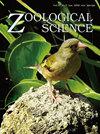海鞘动物卵巢卵泡发育
IF 0.9
4区 生物学
Q3 ZOOLOGY
引用次数: 0
摘要
卵巢卵泡发育是有性生殖动物延续的重要过程,受内分泌、神经内分泌、神经系统中的神经肽和多肽激素等多种调节因子的控制。此外,虽然卵泡发育的一些分子机制是保守的,但其他机制在物种之间存在差异。因此,卵泡发育过程与物种的进化和多样性密切相关。海鞘A型(Ciona rubusta)是一种世界性的海鞘物种,是脊椎动物的近亲。然而,与脊椎动物不同,海鞘不具有下丘脑-垂体-性腺轴,包括垂体促性腺激素和性类固醇。结合海鞘作为脊椎动物近亲的系统发育地位,这些形态和内分泌特征表明,海鞘在卵泡发育中具有共同的和物种特异性的调节机制。到目前为止,一些神经肽已被证明参与卵黄原性卵泡的生长,卵黄后卵泡的卵母细胞成熟,以及完全成熟卵泡的排卵,以特定的发育阶段方式。此外,最近的研究揭示了整个脊索动物卵泡发育的进化过程。本文综述了神经肽能在中国早卵泡发育、卵母细胞成熟和排卵中的分子机制,并对哺乳动物和硬骨鱼卵泡发育过程进行了比较。本文章由计算机程序翻译,如有差异,请以英文原文为准。
Ovarian Follicle Development in Ascidians
Ovarian follicle development is an essential process for continuation of sexually reproductive animals, and is controlled by a wide variety of regulatory factors such as neuropeptides and peptide hormones in the endocrine, neuroendocrine, and nervous systems. Moreover, while some molecular mechanisms underlying follicle development are conserved, others vary among species. Consequently, follicle development processes are closely related to the evolution and diversity of species. Ciona intestinalis type A (Ciona rubusta) is a cosmopolitan species of ascidians, which are the closest relative of vertebrates. However, unlike vertebrates, ascidians are not endowed with the hypothalamus-pituitary-gonadal axis involving pituitary gonadotropins and sexual steroids. Combined with the phylogenetic position of ascidians as the closest relative of vertebrates, such morphological and endocrine features suggest that ascidians possess both common and species-specific regulatory mechanisms in follicle development. To date, several neuropeptides have been shown to participate in the growth of vitellogenic follicles, oocyte maturation of postvitellogenic follicles, and ovulation of fully mature follicles in a developmental stage-specific fashion. Furthermore, recent studies have shed light on the evolutionary processes of follicle development throughout chordates. In this review, we provide an overview of the neuropeptidergic molecular mechanism in the premature follicle growth, oocyte maturation, and ovulation in Ciona, and comparative views of the follicle development processes of mammals and teleosts.
求助全文
通过发布文献求助,成功后即可免费获取论文全文。
去求助
来源期刊

Zoological Science
生物-动物学
CiteScore
1.70
自引率
11.10%
发文量
59
审稿时长
1 months
期刊介绍:
Zoological Science is published by the Zoological Society of Japan and devoted to publication of original articles, reviews and editorials that cover the broad field of zoology. The journal was founded in 1984 as a result of the consolidation of Zoological Magazine (1888–1983) and Annotationes Zoologicae Japonenses (1897–1983), the former official journals of the Zoological Society of Japan. Each annual volume consists of six regular issues, one every two months.
 求助内容:
求助内容: 应助结果提醒方式:
应助结果提醒方式:


